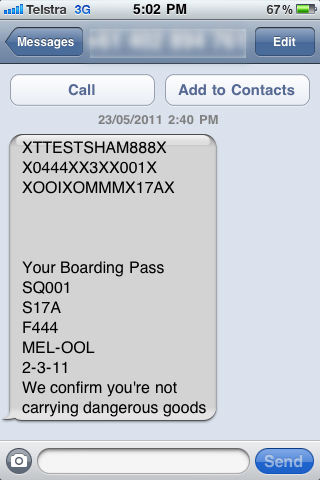Jetstar extends SMS check-in to all phones

Jetstar has retrofitted its entire kiosk fleet with cameras to enable SMS text recognition.

A test of Jetstar's SMS check-in system. The kiosk cameras read the machine code at the top of the message with plain-text instructions at the bottom.(Credit: Luke Hopewell/ZDNet Australia)
Jetstar's 142 self check-in kiosks, built by IBM, now allow customers to check in by holding up an SMS message in front of the kiosk's new in-built video camera which, according to Jetstar's chief information officer, Stephen Tame, will recognise the message and check users in within two to three seconds.
Tame told ZDNet Australia that when passengers purchase their ticket, they are asked whether or not they would like to be automatically checked into their flight and return flight. Jetstar's check-in system then sends the customer a plain text SMS which they can then show to any of Jetstar's computer kiosks, which subsequently produce a boarding pass and bag tags if required.
Jetstar already had the ability to check in via mobile phone, however, it wasn't compatible with all mobile phones. Tame explained that the difference between the new retrofitted kiosks and existing mobile check-in services is how the boarding pass information is sent.
"[Currently, passengers get] a 2D barcode or MCode. There're only two ways you can get an MCode to a phone. You can send it via MMS but that's expensive and you need to know the exact make and model before you send it. The other way is an email or web link and you need a data plan for that," he said.
Tame said that by sending the SMS in plain text, the check in system will work quickly on nearly all phones.
"The objective is to read 95 per cent of all phones first time. It has to do so and print you a boarding pass in less than two seconds," he said, adding that the system currently manages 93 per cent of handsets in 2 to 3 seconds, but that new software would speed that up.
The new SMS system also allows passengers without bags to bypass the concourse check-in counter altogether and head straight to the gate. Jetstar ground staff now have portable SMS scanning technology at the gate, which can run on 240 Volt power or on batteries for eight hours and communicates wirelessly to a laptop. The laptop verifies passenger data by communicating to Jetstar's reservation system via a 3G network.
Tame said that one of the challenges with deploying the camera-based system was being able to adapt to different lighting in airports and on screens.
"We've taken dynamic control over the cameras and we can increase or decrease the sensitivity to light to pick up dark and light phones," he said.
Jetstar has increased the number of self check-in kiosks at its airports and Tame said that the low-cost airline is aiming for 100 per cent self-service. To push that agenda, the airline will start charging customers for using non-self-service offerings at the beginning of November.
"That's what a lot of airlines internationally have been doing, specifically in Europe. That would be the extra cost of providing services at airports."
"We've given the leisure and domestic passenger the ability to use self-service everywhere, without exception, so there should be no reason why passengers could not or would not be using self-service," he said.
Tame said that the new self-service enhancements would not lead to cuts in the number of customer-facing ground staff at airports.
(Front page image credit: Jetstar check-in image by David McKelvey, CC BY 2.0)